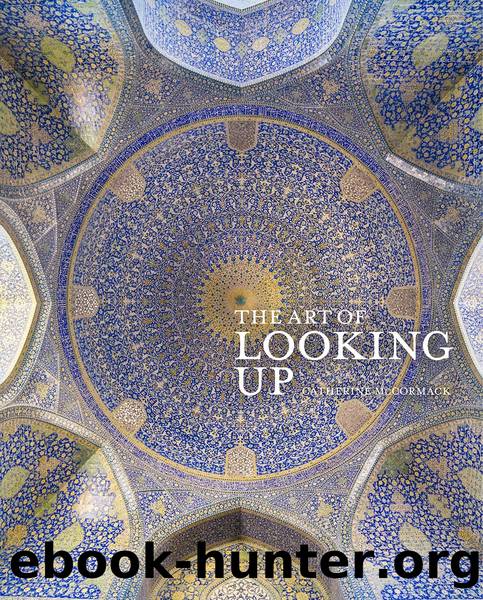The Art of Looking Up by Catherine McCormack

Author:Catherine McCormack
Language: eng
Format: epub
Publisher: White Lion Publishing
Published: 2019-07-15T00:00:00+00:00
Peter Paul Rubens, The Union of the Crowns. The countries of Scotland and England appear as female personifications dressed in red (England) and white (Scotland).
Peter Paul Rubens, The Peaceful Reign of James I.
A full view of the nine canvases of Rubens’ ceiling at the Banqueting House.
Alhambra Palace, Spain
Hall of the Abencerrajes
14th Century
Alhambra Palace, Granada, Spain
In tales of power, extreme beauty and extreme violence are rarely absent. So, the golden honeycombed ceiling of the Sala de los Abencerrajes in the Alhambra Palace bears silent witness to a glorious and gory past and the Nasrid caliphate that occupied the palace as its seat from 1334–91. Nestled in the Assabica Hills of Granada in Andalusia, Spain, the grandiose complex is the oldest Muslim palace to have survived from the Middle Ages. Described by Moorish poets as a ‘pearl among emeralds’ in allusion to the green space of the forests that surround it, the palace’s prevailing design aesthetic was to replicate a sense of paradise on Earth. To do this without images, which were – and continue to be – a graven taboo in Muslim culture, the decoration and aesthetic experience of the Alhambra relies on the effects of the forces of nature at play with the architecture and manipulation of materials such as stucco and stone.
For example, the palace is designed around quadrangles, allowing the inter-penetration of exterior courtyards open to the dazzling sunlight, while creating shadowy interior spaces. Furthermore, the movement of water is sensed everywhere, from fountains whose flow is stemmed to arrive in pools contained within marble basins that reflect the colours, inscriptions and textured surfaces of the interiors. To mark the transition between such spaces, Islamic architecture uses the characteristic feature of the muqarnas. This elaborate structure resembles the naturally occurring phenomena of honeycomb and stalactite formations and was typically applied to the undersides of domes, pendentives, cornices, squinches, arches and vaults to differentiate and transition between smooth planes of architecture.
In the Hall of the Abencerrajes, a glorious octagonal golden starburst of muqarnas forms a canopy above the room. In a world without images, the splendour and complexity of universal creation needed to be celebrated in different, more metaphysical ways, and the elaborate technical design of the muqarnas, with their numerous distinct units, conveyed the many atomic particles of existence – all in connection with God. Contemplated in this way, the muqarnas marked a transitory space between the finite living world and the eternal spirit world, the entry point to which was represented by the dome extending up towards an imagined heavenly sphere.
Historians have suggested that the relatively closed nature of the Hall of the Abencerrajes denotes its former function as a winter music room. Here, sound and vision could intermingle, with the vibrating chords of plucked instruments and flutes heard through shafts of coloured light from the many stained-glass windows beneath the muqarnas. Just as in Christian churches, the effect was to stimulate the senses into perceiving God in the material world.
However, this paradisiacal serenity is interrupted by the legend that gives the hall its name.
Download
This site does not store any files on its server. We only index and link to content provided by other sites. Please contact the content providers to delete copyright contents if any and email us, we'll remove relevant links or contents immediately.
| Body Art & Tattoo | Calligraphy |
| Ceramics | Conceptual |
| Digital | Erotic |
| Film & Video | Glass |
| Graffiti & Street Art | Illuminations |
| Installations | Mixed Media |
| Mosaic | Prints |
| Public Art | Video Games |
Kathy Andrews Collection by Kathy Andrews(10554)
Thirteen Reasons Why by Jay Asher(7803)
The Red Files by Lee Winter(2923)
How to Do Nothing by Jenny Odell(2651)
The Genius of Japanese Carpentry by Azby Brown(2616)
Stacked Decks by The Rotenberg Collection(2283)
Tattoo Art by Doralba Picerno(2087)
Champions of Illusion by Susana Martinez-Conde & Stephen Macknik(2080)
The Art of Doom by Bethesda(1777)
The Artist's Way Workbook by Cameron Julia(1736)
Calligraphy For Dummies by Jim Bennett(1645)
Creative Character Design by Bryan Tillman(1563)
Botanical Line Drawing by Peggy Dean(1534)
One Drawing A Day by Veronica Lawlor(1497)
Wall and Piece by Banksy(1463)
The Art of Creative Watercolor by Danielle Donaldson(1455)
Art Of Atari by Tim Lapetino(1329)
Happy Hand Lettering by Jen Wagner(1325)
Artificial Intelligence for Games by Ian Millington & John Funge(1305)
